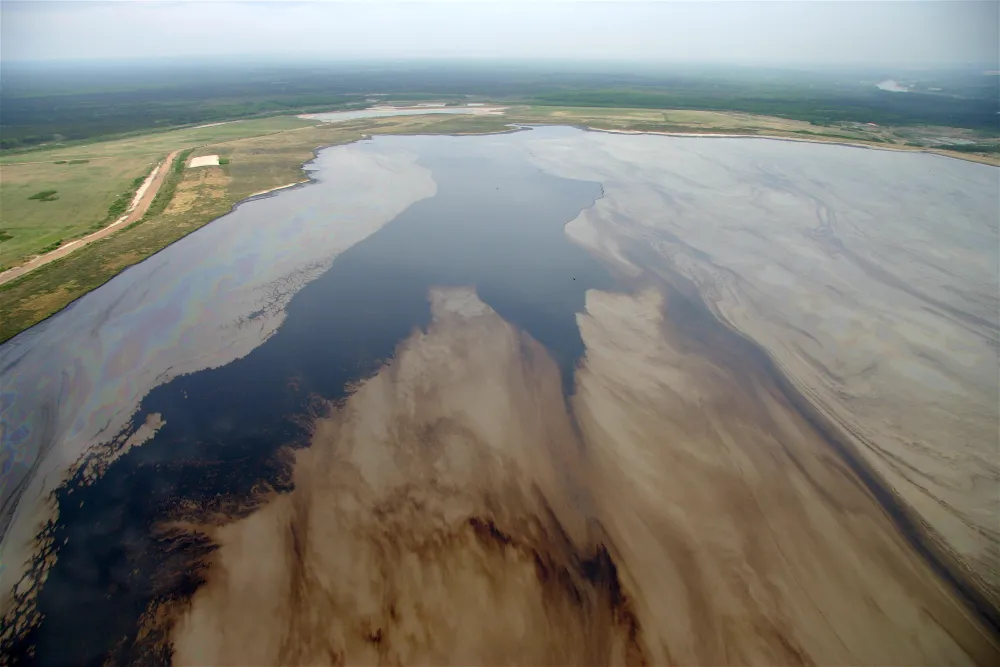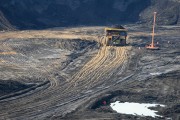Criticism of the oilsands’ environmental impact has been muted recently. With an economic slump that has slowed the rate of oilsands expansion and significant steps forward on climate change policy in the province and federally, it’s easy for old problems to slip from public view. One facet of the oilsands that has dropped in prominence compared to its heyday as environmental headliner nearly a decade ago is the problem of oilsands tailings waste. While the issue may have disappeared from the headlines, it’s not because this toxic legacy has been resolved.
About tailings
Fluid tailings — known formally as mature fine tailings — are the toxic by-product of oilsands mining. The slurry sieved from the mining process is deposited as waste in enormous holding lakes, and they contain a host of toxic materials including bitumen, naphthenic acids, cyanide, phenols, arsenic, cadmium, chromium, copper, lead and zinc. They are released during oilsands processing and build up in tailings lakes over time — and there is evidence these lakes may leak.
In 2015 (the last time for which data is available) there were 1.18 trillion litres of tailings on Alberta’s landscape, covering an area roughly the size of the city of Kelowna. The volume of the lakes continues to grow.
Fluid tailings are warm when disposed of, so tailings lakes don’t freeze in the winter. Because of this, wildlife are attracted to the toxic lakes in cold weather. Mine operators typically use air cannons in an attempt to scare off birds and other wildlife, but these measures are not always successful. If animals are exposed to the lakes, they can become covered in residual bitumen, a potentially deadly fate. Two notorious examples of the risk tailings pose to wildlife occurred in 2008 when 1,600 migrating ducks died after landing in a Syncrude operated tailings lake. Again in 2010, despite heightened attempts to dissuade wildlife from approaching the toxic water bodies, another 230 ducks died in one of Syncrude’s ponds.
Tailings also emit a range of harmful air pollutants: volatile organic compounds (VOCs), greenhouse gases, hydrogen sulphide and nitrous oxides. VOCs are suspected to have serious human health impacts but are not adequately monitored in the oilsands.
Cleanup techniques still experimental
Despite efforts by oilsands companies to figure out how to clean up tailings, there is still no method that is proven to work. Technologies such as centrifugation, tailings reduction technology, and carbon dioxide amended tailings have been proposed by companies. Unfortunately, there is a still significant uncertainty over whether any of them will work in the long term or on a large scale. For instance, proposed end pit lakes would allow companies to dump untreated fluid tailings into old mine pits and cap them with freshwater from the Athabasca River. There is no guarantee that approach will permanently separate the toxic tailings from the rest of the environment.
But tailings management in the oilsands is about to return to the forefront again. The Government of Alberta has released a new Tailings Management Framework that requires companies to resubmit plans to demonstrate how they will deal with the tailings issue.
Last chance to address tailings
November 1, 2016 was the deadline for all oilsands mining companies to submit applications to the Alberta Energy Regulator describing how they intend to meet new rules to clean up the oilsands tailings. The Pembina Institute will be working to review all these plans to ensure that improvements are being implemented.
In my next blog, Three strikes and you're out?, I discuss the history of failed attempts to regulate oilsands tailings, and in Will Alberta's oilsands tailings finally be cleaned up?, how implementation of the Tailings Management Framework provides a last chance for Alberta and the industry to address tailings adequately.
For more information on tailings management in Alberta, please check out Pembina Institute's recent whitepaper on Directive 85, and Statements of Concern on industry's individual management plans.










